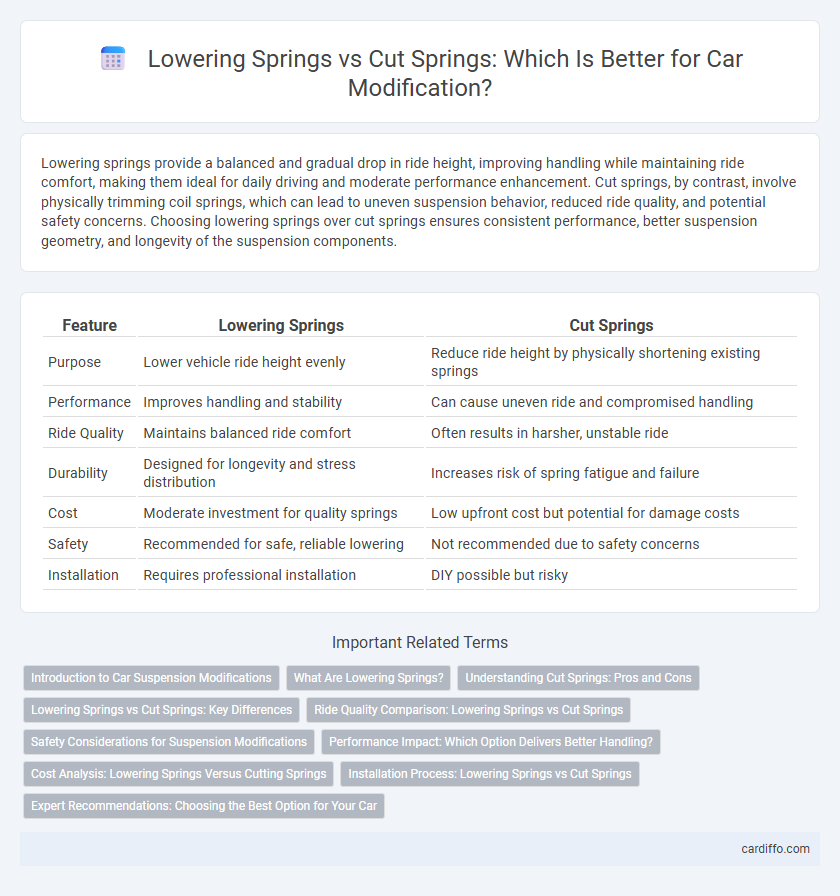Lowering springs provide a balanced and gradual drop in ride height, improving handling while maintaining ride comfort, making them ideal for daily driving and moderate performance enhancement. Cut springs, by contrast, involve physically trimming coil springs, which can lead to uneven suspension behavior, reduced ride quality, and potential safety concerns. Choosing lowering springs over cut springs ensures consistent performance, better suspension geometry, and longevity of the suspension components.
Table of Comparison
| Feature | Lowering Springs | Cut Springs |
|---|---|---|
| Purpose | Lower vehicle ride height evenly | Reduce ride height by physically shortening existing springs |
| Performance | Improves handling and stability | Can cause uneven ride and compromised handling |
| Ride Quality | Maintains balanced ride comfort | Often results in harsher, unstable ride |
| Durability | Designed for longevity and stress distribution | Increases risk of spring fatigue and failure |
| Cost | Moderate investment for quality springs | Low upfront cost but potential for damage costs |
| Safety | Recommended for safe, reliable lowering | Not recommended due to safety concerns |
| Installation | Requires professional installation | DIY possible but risky |
Introduction to Car Suspension Modifications
Lowering springs improve vehicle handling and aesthetics by reducing ride height while maintaining factory suspension geometry and ride quality. Cut springs offer a budget-friendly way to lower a car, but result in uneven spring tension and compromised suspension performance. Choosing lowering springs ensures safer handling and consistent ride characteristics compared to the unpredictable effects of cutting stock springs.
What Are Lowering Springs?
Lowering springs are performance-oriented suspension components designed to reduce the ride height of a vehicle by replacing the stock springs with shorter, stiffer ones. They improve handling by lowering the center of gravity, enhancing cornering stability, and reducing body roll during aggressive driving. Unlike cut springs, lowering springs are engineered specifically for suspension modification, ensuring consistent ride quality and safety.
Understanding Cut Springs: Pros and Cons
Cut springs offer a budget-friendly option for lowering a vehicle by trimming existing coil springs, but this method often results in uneven ride height and compromised suspension performance. Unlike purpose-built lowering springs, cut springs can lead to premature wear, reduced handling stability, and potential safety concerns due to altered spring rates. Understanding these drawbacks is crucial for enthusiasts seeking reliable and consistent suspension modification results.
Lowering Springs vs Cut Springs: Key Differences
Lowering springs are specifically engineered to reduce vehicle ride height while maintaining the integrity of the suspension geometry, offering improved handling and ride quality. Cut springs involve physically trimming coil springs, which can lead to uneven ride height, compromised suspension performance, and potential safety issues. Choosing lowering springs over cut springs ensures consistent spring rates, enhanced stability, and preserves manufacturer safety standards.
Ride Quality Comparison: Lowering Springs vs Cut Springs
Lowering springs are engineered with specific spring rates and coil designs that maintain consistent ride quality while reducing vehicle height, providing improved handling and stability compared to cut springs. Cut springs, by contrast, often lead to compromised ride quality due to uneven tension distribution and increased stiffness, resulting in a harsher ride and potential safety issues. Optimizing suspension performance and preserving comfort, lowering springs offer a more reliable and balanced approach for lowering vehicles.
Safety Considerations for Suspension Modifications
Lowering springs maintain vehicle stability by providing a gradual ride height reduction, ensuring consistent suspension travel and preserving factory safety standards. Cut springs, on the other hand, compromise suspension geometry and ride quality, increasing risks of uneven tire wear, poor handling, and potential failure during driving. Choosing lowering springs enhances suspension reliability and occupant safety compared to the hazardous alterations caused by cut springs.
Performance Impact: Which Option Delivers Better Handling?
Lowering springs offer a balanced performance improvement by reducing ride height and enhancing suspension response, resulting in better cornering and stability without significantly compromising ride comfort. Cut springs lower the vehicle by physically shortening stock springs but often lead to inconsistent ride quality, reduced suspension travel, and potential handling issues due to altered spring rates. Overall, lowering springs deliver superior handling benefits by optimizing suspension dynamics and maintaining structural integrity compared to cut springs.
Cost Analysis: Lowering Springs Versus Cutting Springs
Lowering springs typically cost between $100 and $300, offering a cost-effective solution for reducing ride height and improving vehicle handling without compromising spring integrity. Cutting springs, while initially cheaper or even free if performed DIY, risks structural damage and uneven ride height, potentially leading to costly suspension repairs and compromised safety. Overall, lowering springs provide a more reliable and economically sound investment compared to the unpredictable expenses associated with cutting springs.
Installation Process: Lowering Springs vs Cut Springs
Lowering springs typically require a straightforward installation process, involving the removal of the factory springs and replacing them with pre-cut, precision-engineered springs designed for consistent ride height and improved handling. Cut springs demand careful measurement and evenly trimming stock springs, which can introduce risks of uneven ride height, compromised suspension performance, and potential safety issues. Professional installation is highly recommended for both, but lowering springs offer a safer and more reliable option due to their pre-manufactured specifications.
Expert Recommendations: Choosing the Best Option for Your Car
Experts recommend lowering springs for a balanced combination of improved handling and daily drivability, offering consistent ride quality without extensive suspension changes. Cut springs, while a cheaper alternative, often lead to uneven ride height and compromised safety due to altered spring tension and factory specifications. For optimal performance and vehicle integrity, professional mechanics advise selecting lowering springs tailored to your car's make and model.
Lowering springs vs Cut springs Infographic

 cardiffo.com
cardiffo.com